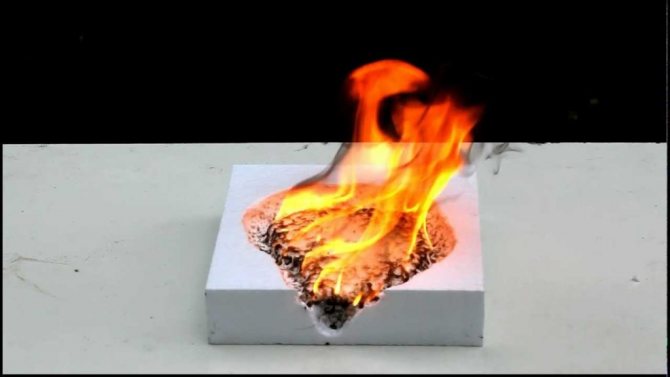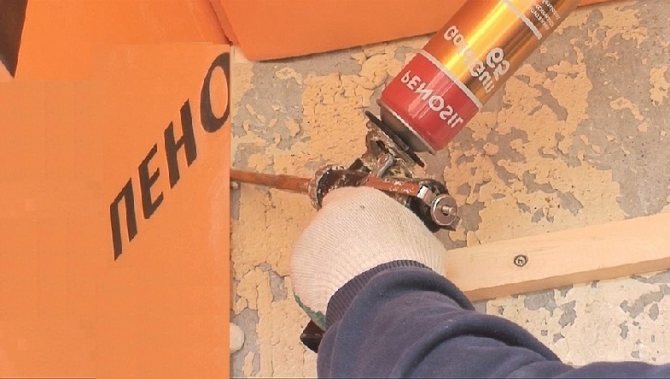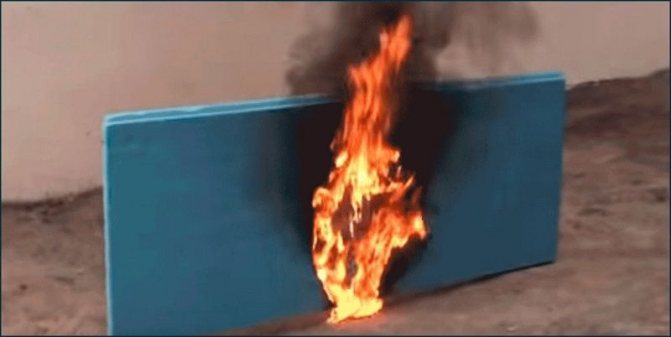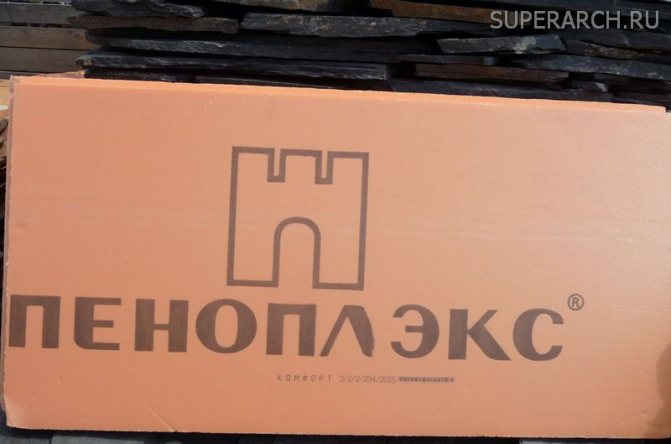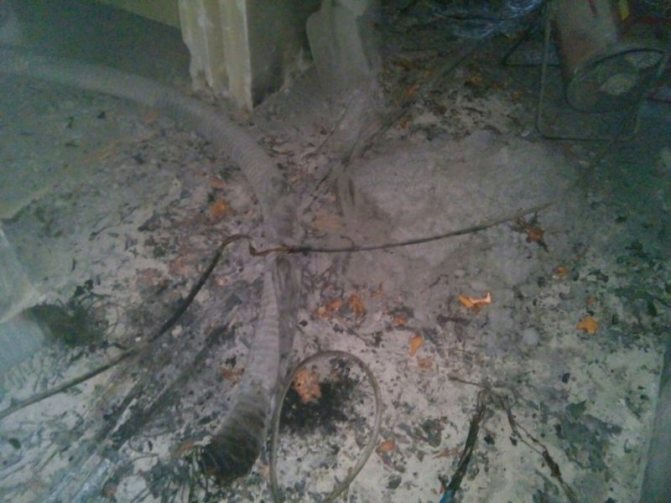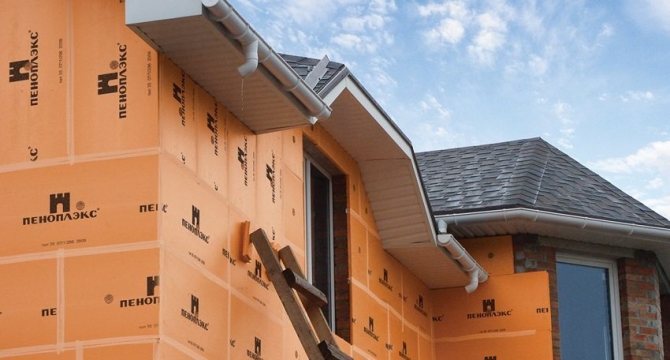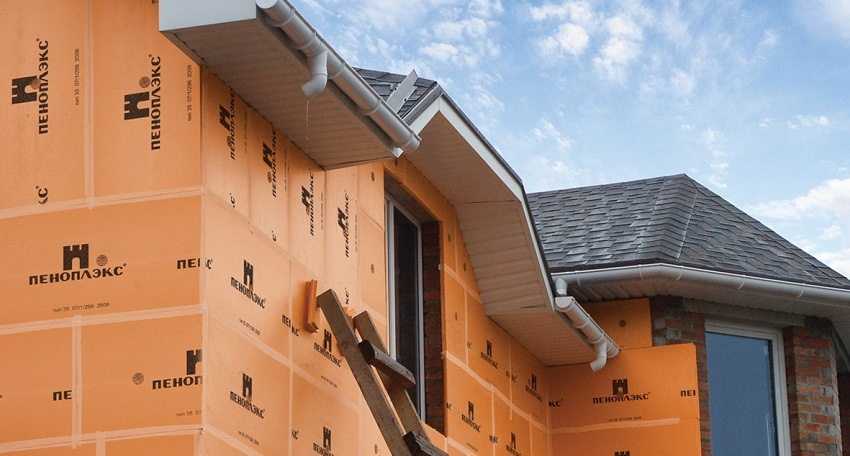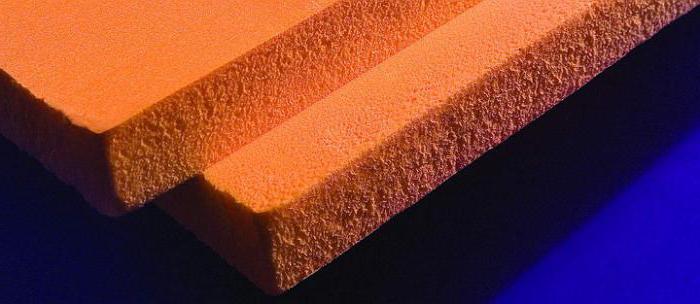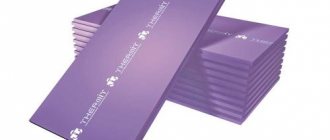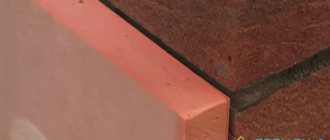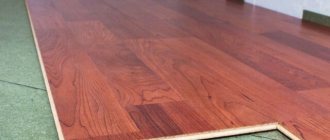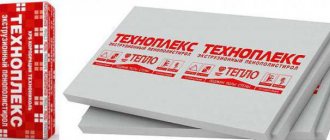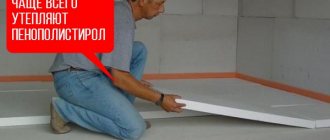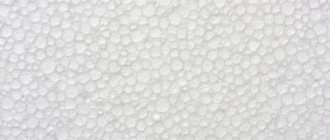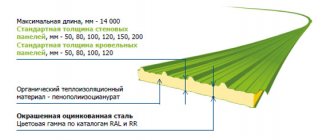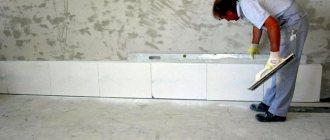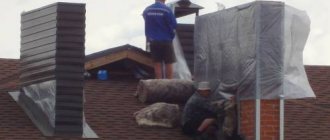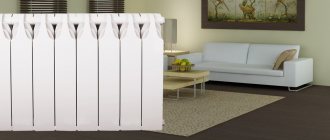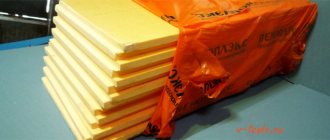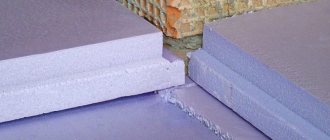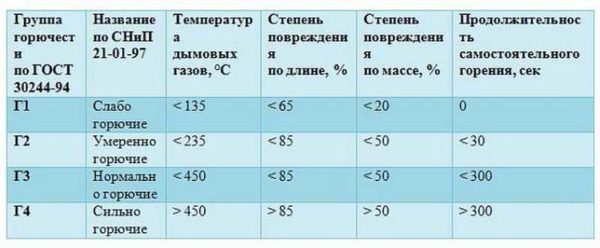
Flammability is not the best characteristic
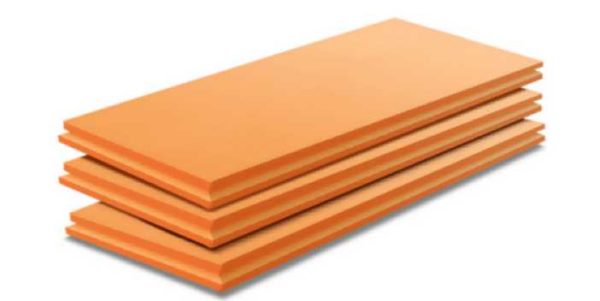

Plates for insulation Penoplex are of different thicknesses and densities
As you can see, in terms of temperature indicators, any type of Penoplex can be used in any part of the country - from the south to the north. Moreover, if it is left to "winter" in an unprotected form, nothing will happen to the material. This is not the merit of Penoplex, but the general property of extruded polystyrene foam.
What distinguishes the different types
The manufacturer divided the types of Penoplex into areas of use. Their properties are optimal for a specific application. For example, the increased density of EPS, required under the screed, will not be needed when it is installed on the base. Taking into account that the price differs significantly, it makes no sense to use the “Foundation” brand for other purposes. But the difference in locks, all other things being equal, can be neglected. Here we are talking about ease of installation. Although, this is also important.
Investigating the flammability of extruded polystyrene foam
When choosing a material in order to insulate a house, people are guided by different principles. For some, the price is important, for others - ease of use, while others pay close attention to parameters such as environmental friendliness and fire safety. In this regard, what can you tell about extruded polystyrene foam - is it slightly flammable or is it dangerous in case of fire? You can find many different opinions about the flammability of extruded polystyrene foam, and sometimes they are even opposite. Let's try to figure out what is the matter here.
What is the danger of styrene
Before considering the harmfulness of polystyrene, it is worth understanding the features of the use and impact on the body of its main component.
Styrene (phenylethylene) is a toxic colorless compound that is the basis of most polymers produced. With a direct effect on the human body, it has a pronounced toxicological effect, leading to a disorder of the functions of the central nervous system, autonomic disorders and blood diseases.
In addition, the following negative effects of the substance are worth noting:
- its accumulation in the liver, which, when a certain concentration is reached, can lead to organ pathology;
- deterioration of the heart and weakening of the heart muscle;
- influence on the formation of the fetus, the health of pregnant women;
- irritation of the respiratory tract and mucous membranes.
Fortunately, for the appearance of serious disorders in the work of the body, a person needs to receive a significant concentration of the substance. It is for this reason that the danger imposed on polystyrene is greatly exaggerated. Even if a person is surrounded by an insulation based on it all his life, he will not receive a dose sufficient for poisoning.
This substance has a pronounced cumulative effect, that is, it accumulates in the body over time. According to rough estimates of scientists, over 20 years, the concentration of styrene in the body can increase 600 times compared to the initial one. At a constant concentration of the substance in the environment. However, in its pure form, for the release of styrene into the environment, a temperature regime of 25 degrees is required. This substance becomes much more toxic when exposed to high temperatures, since its release increases many times over.
But it is important to take into account that polystyrene made on its basis is harmful only in case of fire. This is explained by the specifics of its production.
Flammability class of extruded polystyrene foam
Speaking about the flammability of extruded (extruded) polystyrene foam, it should be borne in mind that various grades of it are produced. With general similar thermal insulation characteristics, they, however, differ in fire hazard class. Thus, opinions that extruded polystyrene foam is low-flammable or non-flammable at all may also have a right to exist. But is it really so?
- G1 - slightly flammable
- G3 - normally flammable
- G4 - highly flammable
- NG - non-flammable
G2 - moderately flammable
It is only natural that sellers seeking to advertise a product claim fire safety. They claim that they do not sell flammable extruded polystyrene foam, but a material that is quite fire resistant. If you come across such an offer - do not believe it! You are either misled, or you yourself were confused: there is no non-combustible extruded polystyrene foam - the price of such a statement is zero. Another thing is that it can belong to class G1 - low-flammable materials. Is the difference small? Sellers think that way. By the way, do not confuse it with simply non-flammable polystyrene foam (not extruded), that is, foam.
What about extruded polystyrene foam - is it dangerous when it burns? Let's take as an example the products that occupy half of the entire thermal insulation market in Russia. Until recently, insulation of this brand was attributed to hazard classes G3 and G4, indicating also the harmful substances that extruded polystyrene foam emits during combustion. Relatively recently, the products received a new fire certificate, in which class G1 was assigned to some of its types (in particular, Penoplex-35). To obtain low-flammable extruded polystyrene foam, a flame retardant additive was introduced into its composition, which significantly increased the resistance of the material to fire. According to the company's specialists, unlike many other organic materials, when burning, such extruded polystyrene foam emits no more harmful substances than ordinary wood - only carbon monoxide and carbon dioxide.
However, consumers are far from always inclined to believe the manufacturer and are certainly not going to heat the stoves with penoplex to check this statement. Many are convinced that this study, conducted by the Independent Testing Center for Fire Safety of the City of St. Petersburg, is not entirely true, and are more inclined to trust government agencies. And they just assert that non-combustible extruded polystyrene foam does not exist in nature, and assign it flammability classes G3 and G4.
What is flammability
Flammability is a characteristic of a heat-insulating material, showing the ability to develop combustion and spread open fire. The flammability class is determined by the index assigned during the tests from G1 to G4. The fire hazard classes of building materials can be viewed in the table:
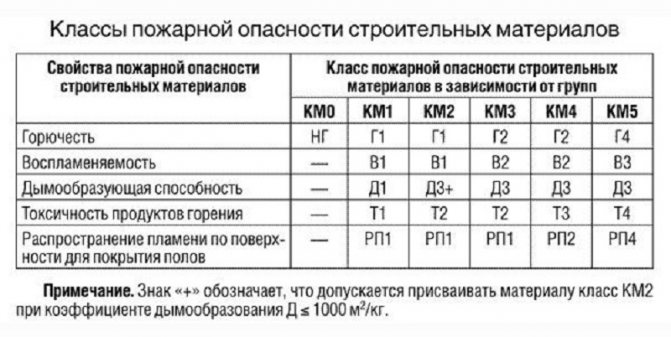

In addition, the flammability of thermal insulation materials have such indicators as: flammability (C), smoke generation (D), toxicity of combustion products (T). Let's consider these parameters using the example of the most popular heat insulators: ordinary foam and extruded polystyrene foam, mineral wool and insulation made of porous concrete D-140 "Velit".
Does Penoplex burn and not?
It is worth mentioning that on the official websites of Penoplex information that extruded polystyrene foam is not combustible cannot be found. There are only a few words about that very independent research and compliance with GOST. But it is precisely this moment that raises questions.In addition, not all consumers are convinced that the combustion products of extruded polystyrene foam are so harmless. It is possible that the distrustful simply did not have to meet with material treated with flame retardants. These substances prevent combustion (but not fire). That is, when exposed to a high temperature flame, the insulation will light up, but will quickly go out as soon as it comes out from under its influence. Apparently, this is why the processed extruded polystyrene foam is unofficially called non-combustible - by itself it cannot cause a fire and does not interfere with its extinguishing.
As for the combustion products of the same penoplex, it is still not necessary to compare with what is released when burning a tree. Say what you like, but this is an artificial product. During combustion, it emits not only CO (carbon dioxide) and water vapor, but also soot and hydrogen chloride, the inhalation of which is fraught with severe suffocation and pulmonary edema.
Let's summarize everything we've learned about extruded polystyrene foam - is it non-flammable, is it safe? how does the price differ from the usual one?
- The flammability of conventional extruded polystyrene foam is usually in the G3 and G4 classes
- Special flame retardant additives are able to raise the flammability class of the heat insulator to G1
- It can be called non-combustible only conditionally, meaning its high resistance to fire.
- The products emitted by extruded polystyrene foam during combustion are quite dangerous.
The price for "conditionally non-combustible" extruded polystyrene foam is not much different from the usual one. This is also due to the fact that, in principle, its density is higher - class G1 is assigned to penoplex with a density of 35, while penoplex-31 remains a fire hazardous material with class G4. A cubic meter of low-flammable Penoplex-35 costs about 4200-4300 rubles. Other manufacturers of extruded polystyrene foam - Technonikol, Ursa, etc., also produce products in the processing of which fire retardants are used.
It is worth remembering that fire safety depends not only on the material itself, but also on the correctness of its application. Highly flammable penoplex is intended for insulation of foundations, basements, floors, and in no case facades and walls. It is the fire hazard that is one of the characteristics that hinder the even wider use of this heat insulator. However, this problem is being solved by the manufacturer, and it is possible that soon the use of non-combustible extruded polystyrene foam will become the norm in construction.
What is Penoplex - its benefits
Penoplex is a modern material for insulation
Currently, there is a huge number of various building materials. Among the wide assortment, the products called "penoplex" stand out.
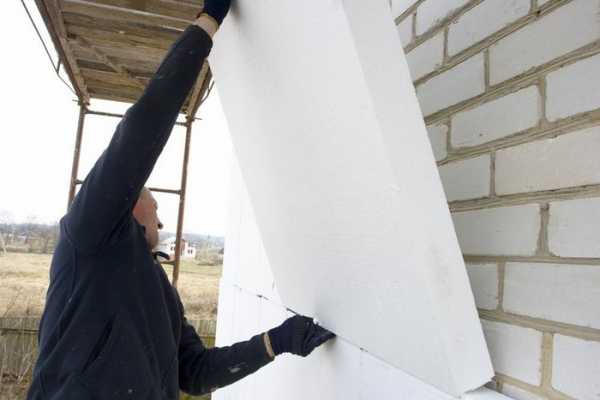

The thermal insulation properties of foam are 10 times higher than that of bricks.
She appeared on the market relatively recently. For this reason, not everyone has an idea about what penoplex is, what characteristics it has, what advantages it has, where it can be used, and what types it is represented.
What is Penoplex?
So, let's start with what the penoplex material is. It is extruded expanded polystyrene. He is a prominent representative of modern thermal insulation materials.
Penoplex is ideal for solving problems related to heat conservation. It is used in both civil and industrial construction.
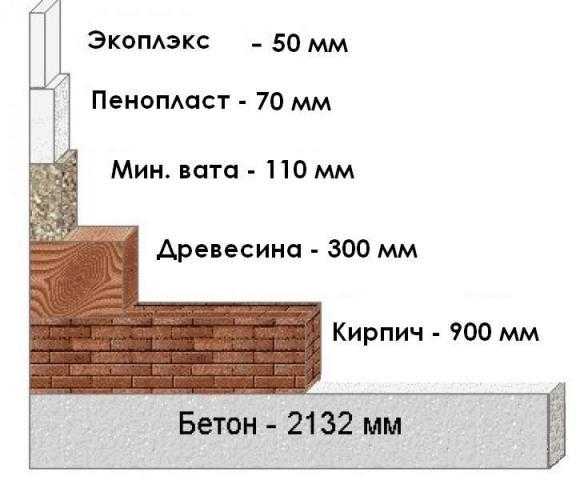

Schedule of types of thermal insulation materials.
This material is made in a special way, the technology was developed in the USA. Thanks to a special technique that provides for extrusion, the finished insulation is obtained with a uniform structure, which consists of small cells (up to 0.2 mm in size), covered with a finishing layer.
Penoplex is produced by mixing granular polystyrene at high temperatures and pressure, a special foaming agent is necessarily introduced into it, which is oxygen dioxide or a mixture of light freons. The latter components are used only of those types that belong to the group of non-flammable, non-toxic and ozone-friendly. After the manufacture of the insulation in the cells, the residues of the blowing agent are quickly replaced by the ambient air.
Types, characteristics and application of penoplex
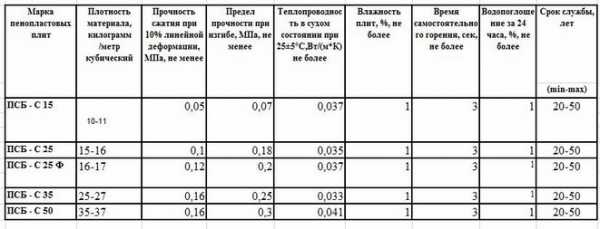

Table of qualitative characteristics of polystyrene.
Penoplex of various types is offered. Each of them has its own characteristics and scope. Let's consider in detail each type:
- Penoplex 31 S - orange-colored insulation boards, which have a density of up to 30 kg / m³ and belong to the G4 flammability group. The scope of this type of material is as follows: horizontal and vertical insulation of facades, roofs, floors. In addition, it is used to create bowls of pools, garden paths, utilities, wells, fire and storage tanks. Another area of application of Penoplex 31 C is the construction of private houses that provide for local water supply and sewerage systems, the pipes of which are located in freezing zones. This material can be used when constructing foundations that are laid at a shallow depth.
- Penoplex 35 - orange-colored insulation boards with a density of up to 37 kg / m³. Non-combustibility class of material G1. It is used to insulate the soles of foundations, facades, roofs, and internal walls. It can be used to create floors in ice arenas, retail and warehouse premises, residential buildings. Penoplex 35 is excellent for thermal insulation of various building envelopes. It can be used to reduce the likelihood of surfaces catching fire, since in the manufacture of this type of insulation, an effective fire retardant with a special additive is used, which is patented by the manufacturer. Due to this composition, the material is highly resistant to combustion.
- Penoplex 45 С - slabs with orange color and density up to 40 kg / m³. Their flammability group is 4. Such insulation is used for roofs that are under load to reduce energy losses in warehouses and retail premises. In addition, Penoplex 45 C is used for the installation of high-quality and durable thermal insulation layers in the structures of railways and highways, runways, for thermal insulation of highly loaded foundations and floors accessible to vehicles.
- Penoplex 75 - orange slabs with a density of up to 53 kg / m³ and a combustibility group 4. This insulation is used mainly when installing heat-insulating layers on airfield runways and when creating floors in aircraft hangars.
It should be noted that all foam boards are supplied in a protective plastic wrap. This allows them to be stored outdoors without the need for UV protection. When using it, only special adhesives should be used.
The main advantages of penoplex
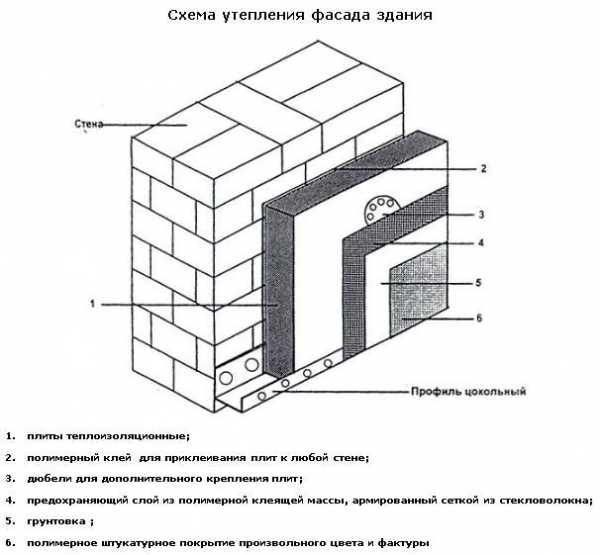

The scheme of insulation of the facade of the building with polystyrene foam.
Modern insulation penoplex has many advantages. The list of the main ones is as follows:
- lack of water absorption. Since the material has a special structure, no liquid gets inside it. The surface itself does not absorb moisture. At the same time, when exposed to a liquid insulation, it does not collapse;
- low thermal conductivity. Penoplex is an effective material. Its thermal conductivity coefficient is at the minimum level and is only 0.030 W / (m × ° С). This value is much lower than that which is present in most of the insulating materials of domestic and foreign production;
- low vapor permeability. Penoplex is highly resistant to water vapor. For slabs with a thickness of 20 mm, the resistance to vapor permeation is equivalent to 1 layer of roofing material;
- durability. The service life of Penoplex insulation is at least 50 years. It is also important that after repeated thawing and freezing, it does not lose its physical and technical properties. Therefore, it can be used in almost any environment;
- excellent compressive strength. Thanks to the use of the extrusion method in production, the material is obtained with a uniform structure. It, in turn, provides penoplex with high and stable compressive strength;
- ease and ease of installation. Plates of this insulation are easy to install and adjust to the required dimensions using a knife. You can work with the material in any weather, and you do not need to use any protective equipment;
- ecological cleanliness. Penoplex refers to materials that are safe for health. Therefore, it can be used even when carrying out thermal insulation work inside residential premises;
- high chemical resistance. Penoplex easily withstands the effects of various building materials, including acids (organic and inorganic), salt solution, caustic alkalis, bleach, alcohol and alcohol dyes, paints, ammonia, carbon dioxide, oxygen, acetylene, propane, butane, fluorinated hydrocarbon (freon), cement (mortars and concrete), animal and vegetable oils, paraffin. When exposed to them on penoplex, it does not soften and does not shrink;
- can be used over a wide temperature range. This material can be used in almost any climatic conditions. It does not lose its characteristics at the following temperatures: from -50 ° C to + 75 ° C;
- insignificant weight. Plates of this insulation have not only optimal dimensions, but also a small weight. This advantage will make it extremely easy to move material around the construction site.
Despite the fact that Penoplex insulation has many advantages, its cost is within reasonable limits. Therefore, when buying it, your budget will not suffer.
Accordingly, it will be possible to carry out insulation work at no extra cost. As for the disadvantages of this material, they are absent.
Summarizing
From the information provided, it is clear that penoplex is a high-quality insulation with high performance characteristics. It has a wide range of applications and does not have a negative impact on the environment.
Its use when carrying out work on thermal insulation will be an excellent solution. Its purchase will not disappoint, because such a modern material has no drawbacks.
Most Popular Blog Articles of the Week
teplomonster.ru
Technical characteristics of the material penoplex
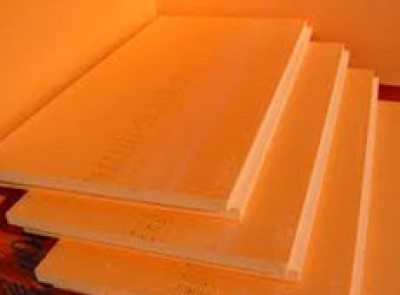

Among the extensive line of heat-insulating materials, one of the first places is occupied by penoplex. Most of those who like to do something with their own hands are attracted by the low price of the slabs of this insulation and the ability to mount them on their own without resorting to the help of workers.
This allows you to significantly save on the insulation of private and country houses. Due to the low thermal conductivity of the foam, the finished structures are quite warm.
What is Extruded Polystyrene Foam
The complex technical name of the insulation alarms many who prefer to use only environmentally friendly, low-combustible materials in the insulation of their homes. Modern technologies make it possible not to use freons as a foaming agent. Therefore, only CO2 or freons are now used for expanded polystyrene granules. So we may well call it environmentally friendly.
The material has a number of characteristics that make it very attractive for private and low-rise buildings, as well as for use on an industrial scale.
- The insulation has no biological component, therefore it does not rot or decompose. These properties make it durable (service life ≥ 50 years).
- Eco-friendly insulation. Moreover, we can even talk about the environmental friendliness of its production.
- It has proven itself in floor heating systems. The entire structure of the "warm floor" is mounted on top of the 35 penoplex. A low coefficient of thermal conductivity will effectively save heat, due to which the cost of heating a house or apartment is significantly reduced.
- Wide range of applications. The insulation can be used both in a country house and at an airfield.
Penoplex technical characteristics are presented in the table below.
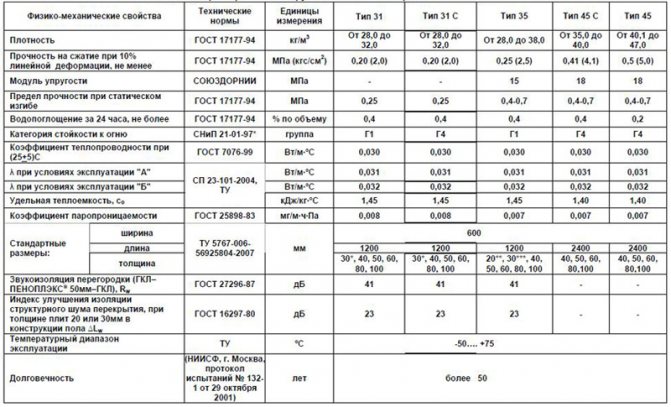

Advantages and disadvantages of penoplex
Insulation advantages:
- Good thermal insulation properties.
- Low vapor permeability.
- Almost zero water absorption according to GOST 15 588−86. The material does not absorb moisture and evaporation, therefore it can be used for thermal insulation of baths and saunas.
- High strength. Penoplex can withstand significant tensile and compressive loads.
- Good soundproofing.
- The service life of the material is up to 50 years, during which the insulation retains all its properties and initial shape.
- Even with a long service life, the material retains its chemical structure and does not decompose into toxic components, thereby not harming humans and the environment.
- Biological resistance. Penoplex Base is not subject to decay and mold.
- Easy to cut and install. The material is cut well with a painting knife and does not require the use of special tools for working with sheets.
- It is possible to insulate the home with penoplex The base can be at any temperature at home or on the street.
- Light weight of the material.
Disadvantages of Penoplex Base:
- Unnatural origin.
- High price.
- Strong smokiness.
Why do some people love Penoplex so much? And why does someone, on the contrary, do not want to use it?
Unfortunately, Penoplex still burns
Like any building material, penoplex has its own strengths and weaknesses. Knowledge of the features of the material will allow you to use it with maximum efficiency; positive characteristics include the following parameters:
- Low thermal conductivity. The thermal conductivity coefficient does not exceed 0.03 W / m · ºK, which indicates a high degree of thermal insulation.
- Low water absorption. 0.5% by volume per month.
- High compressive and flexural strength - 0.27 MPa. This property allows the boards to be used not only as insulation, but also as a building material that is not susceptible to structural cracking.
- Light weight. Due to its low density, the material does not put stress on the supporting elements.
- Wide range of operation. The material does not lose its properties in the range from -50 to 75 ° C.
- Durability. The service life is 30-50 years.
- Simple installation.
Heat-shielding properties of boards in comparison with other materials
In order for penoplex to bring the expected benefits, you should also remember about the disadvantages (and take them into account):
- Low vapor permeability. The indicator is worse than that of polystyrene, which makes you think about a good ventilation system.
- Flammability. Belongs to the class G3-G4 (normally and highly flammable substances).
- Environmental friendliness. The material is safe for health if it does not contain harmful impurities. The existing variety is self-extinguishing polystyrene foam, impregnated with a fire retardant and can have a negative effect on humans.
- Extremely low noise insulation.
- UV instability. It is destroyed by sunlight, needs protection during storage.
- Immunity to a number of organic solvents and other substances.These include gasoline, diesel fuel, oil paints, polyester resins, aromatic hydrocarbons, ethers.
Facade insulation works of complex shape
Where can Penoplex be used?
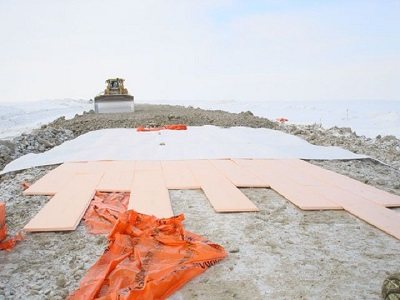

Extruded polystyrene foam has found its application in various fields, both in residential construction and repair, and in industrial.
Its technical characteristics vary widely in terms of such indicators as plate thickness, combustibility, strength, which allows them to insulate both runways at airfields (100 mm thick plates) and house walls, foundations, etc.
Penoplex markings
There are several penoplex markings, such as M35, M45 and others. It should be noted that this is an old marking. They are currently not in production.
- Modern markings - 31C, 35, 45. Penoplex 31C has weak technical characteristics for compression, therefore it is used mainly for insulation of pipes or containers.
- Penoplex 35 is versatile, quite durable, so it can be used to insulate both pipes and walls of buildings, foundations, and can be used in a screed on the floor. The characteristics of this brand have excellent thermal insulation qualities.
- Penoplex 45 can be successfully used for insulating runways at airfields, for insulating deep foundations, floors in industrial premises. It is indispensable for the arrangement of the road surface. Its density, higher than that of 35, perfectly withstands loads, and the almost complete absence of water absorption does not allow the canvas to swell after heavy showers and subsequent frosts. For 45, there are no prohibitions for use on a production scale.
We insulate the balcony with penoplex: methods and video
Penoplex is inserted into the crate and fixed with nails with a plastic lining
It is possible to insulate the balcony with penoplex in different ways. For example, insert penoplex into the crate. And then additionally fix it with special dowels with a wide plastic head. Moreover, there are 2-4 such dowels per sheet of insulation.
If you are not going to sheathe the insulation, you can do without the sheathing. Just place the penoplex on the dowels. Or glue it with construction glue, polyurethane foam or cement mortar. Believe me, these substances will not harm penoplex in any way!
In modern suburban construction, the installation of foam boards is carried out in three ways:
- Using an adhesive. A universal method suitable for insulating a large surface, facade or basement, followed by plastering.
- Using fasteners. If a significant load on the insulation layer is not expected, the sheets are attached using plastic disc dowels. The method is suitable for insulating a basement or loggia.
- Using polyurethane foam. The advantage of polyurethane foam is that high adhesion (adhesion to the surface) plays an important role in insulating floors, attic floors and walls.
Slab mounting methods
What is Penoplex good for?
The properties of penoplex are varied, which is very convenient for do-it-yourself work, in the country or in a private house.
- Ease of installation and low weight make it easy to mount this insulation without the help of specialists.
- Such characteristics of foam as a low coefficient of thermal conductivity, density and others allow it to be used not only for external insulation, but also for thermal insulation of floors at the construction stage. Plates with a density of 45, with a thickness of 50 mm and more, can easily withstand a concrete screed, serving in the future as an excellent service. You will always have a relatively warm floor.
- Penoplex plates, 20 mm, 30 mm, 50 mm thick and higher, will make the walls, floor and roof warmer. Now you don't have to worry about buying warm slippers or a sweater. Penoplex will reliably protect you from bad weather.
- Such quality of penoplex as vapor permeability baffles many.After all, we are used to counting and hearing from sellers in hardware stores that the walls (floor, roof) must breathe. But think about it. Through these micropores, our house (wood or brick) not only breathes, but also loses heat. Using Penoplex insulation, simply organize high-quality ventilation in your room by equipping, for example, a micro-ventilation system and supplying an extractor hood. Thus, you will create a healthy microclimate in your home.
Insulation properties
The progenitor of penoplex is polystyrene. In terms of performance, the new insulation completely outperforms its predecessor. But he pulled the minuses along with him. Although expanded polystyrene copes with its tasks better.
Technical and operational characteristics of penoplex:
- high coefficient of thermal conductivity;
- increased density;
- high strength (it is almost impossible to break it with your hands);
- when breaking, the material is not crushed;
- increased fire resistance.
The characteristics of the material are many times superior to foam. Here the manufacturers have tried their best. In addition, many companies have improved expanded polystyrene by treating it with additional chemical compounds. Such a heater is capable of self-extinguishing when ignited.
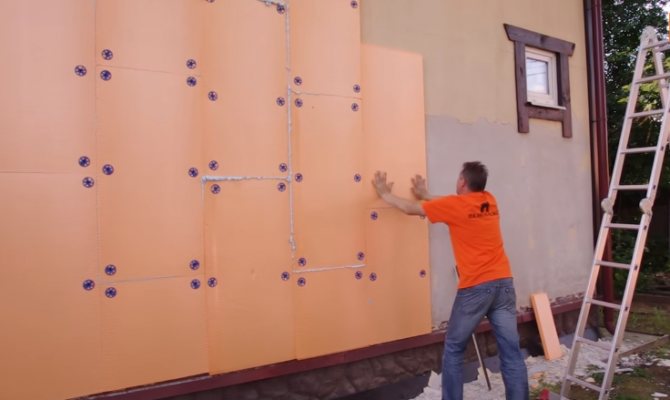

A little about the flammability of penoplex
Most homebrew builders believe that penoplex is no different from polystyrene, except for its structure. Its properties such as flammability and water absorption are equated to the properties of foam. This is not true. Now, both non-combustible polystyrene and completely combustible polystyrene are produced. Therefore, trusting rumors that penoplex burns strongly, or not, is your decision. However, we note that penoplex is deprived of the possibility of spontaneous combustion. In the presence of a source of constant fire, it only melts, with the release of carbon monoxide (CO) and carbon dioxide (CO2) gases. If the fire is extinguished immediately, even smoldering will not be observed. Therefore, when choosing between modern foam and foam, give preference to the second material.
Important... Ordinary foam, which you can easily find in a box with some household appliances, burns perfectly. But it is foolish to think that there is no difference between it and construction foam. None of the varieties of penoplex burns, but only melts in the presence of an open flame source.
Is Penoplex burning or not?
Penoplex refers to low-flammable materials
According to the classification of building materials according to fire hazard, Penoplex was assigned flammability classes G3-G4 (highly combustible and normally combustible materials). However, modern heat-insulating boards are produced with the addition of special substances that prevent combustion - fire retardants, which increases the class of resistance of foam to fire up to G1 (slightly combustible materials).
Although it is characterized by increased smoke production, when burning, it does not emit such toxic substances as hydrocyanic acid and phosgene. Carbonic acid and carbon monoxide emitted with smoke are also formed when other materials are burned - for example, wood or mineral wool.
It is possible to minimize the fire hazard of the penoplex by observing basic safety measures.
When working with it, there should be no sources of open flame nearby. Penoplex without fire retardants can be used for floors, plinths, but when insulating facades and walls, it is strictly recommended to use a heat insulator with anti-flammable additives. Baths, saunas and wooden buildings are undesirable - mineral wool, expanded clay and other heat insulators are better suited here.
Russian brands of penoplex
Russian craftsmen did not bypass the production of such a popular insulation as penoplex. In our market there are brands such as Technoplex from the TechnoNIKOL corporation and Polispen. Let's consider each of them in detail.
Technoplex
Technoplex is designed specifically for private construction, as well as for the arrangement of a warm floor system.In production, nanotechnology is used - graphite particles that enhance the effect of low thermal conductivity and further increase the strength of the material plates. Plates of this insulation are light silver and meet all standards for the production of foam.
Insulation Technoplex is produced with plates with different parameters. Even individual sizes are possible, if requested by the customer. The thickness of the slabs is different - 20, 30, 40, 50 and 100 mm. All plates, except for 20, have a special edge, which, during installation, excludes the appearance of cold bridges. Technoplex boards can be stored both indoors and outdoors, provided that the original packaging is intact. After installation, the surface of the Technoplex insulation must be insulated from atmospheric influences.
Polispen
LLC "Polispen" successfully produces extruded polystyrene foam under the brand of the same name. There are three types of foam boards in production, differing from each other in characteristics - compression density, thermal conductivity coefficient and flammability. These are the brands:
- "Polispen Standard"
- "Polispen 35"
- "Polispen 45"
The numbers 35 and 45 mean the density of the material, respectively 35 kg / m3 and 45 kg / m3. During production, special substances are used that reduce flammability - fire retardants.
Plates "Polispen Standard" are used where their combustible component is the least important - for internal floor insulation, in foundations. Plates with a density of 35 are used to insulate fences and load-bearing structures of buildings. Plates "Polispen" with a density of 45 are used in the arrangement of road surfaces, as well as structures that carry an excess load.
So, we have an excellent thermal insulation material made in the form of plates of various thicknesses - 20, 30, 40, 50, 60, 80 and 100 mm (depending on the manufacturer, the thickness range may vary, the standard range is 20/30/40/50 / 100), impregnated to varying degrees with fire retardants (the price of non-combustible material is more expensive), different density and compressive strength, used both in private housing construction and in industry. Russian penoplex brands such as Tenoplex and Polispen have proven themselves in the Russian market.
Insulation of the facade: the stages of mounting plates on glue
Let us now analyze the individual properties of penoplex in order to finally decide on the issue of its harm to the health of the average person.
After all, it's not a secret for anyone that it is the characteristics that have a greater influence on how the material will behave in a given situation.
Using foam to insulate a balcony
Some heaters themselves are completely safe, but when interacting with the same moisture, they begin to rot, mold, and subsequently release various harmful substances into the air. The same fungal spores or mold discharge, for example.
It is not surprising that people are so careful about installing insulation (in particular, foam for the floor) from inside the premises. Indeed, many have no confidence in the absence of harm from the material used. And a large number of various myths also do not help to calm a person.
2.1 Pros and cons
In short, penoplex has a huge number of advantages. Its unique consistency makes it an extremely useful material.
Main pluses:
- Hydrophobicity;
- A light weight;
- High strength;
- Anti-corrosion compound (foam for wall insulation);
- The ability to mount in any situation;
- Not interesting to rodents and insects.
As for the disadvantages, they are also available for heaters of this class.
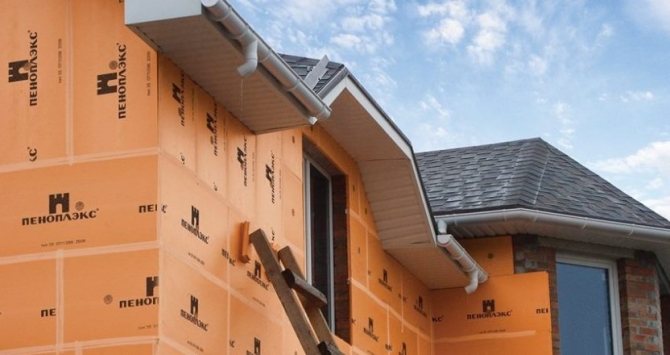

The main cons:
- Penoplex has a flammability class;
- Penoplex is corroded by various solvents;
- It is quite expensive.
Now we will analyze all these properties in more detail in order to finally make a decision about the harmfulness or absence of such in foam insulation.
Penoplex plates, 3 cm thick, close to
Almost the main myth about any insulation is the statement that over time it will start to rot. When rotting, various fungi, mold and a bunch of other microorganisms are formed in the material. It is extremely undesirable for all this person to breathe.
But if we look at penoplex, we will understand that this material, being a polymer, cannot rot by definition.
Likewise with weight and strength. If the foam could still be reproached due to its low strength, then penoplex in this regard has much higher rates. And therefore, the insulation structures assembled from it have a much higher strength.
There is also a widespread belief that expanded polystyrene is loved by rodents as a staple food. Indeed, even field mice eat up ordinary foam very quickly. Moreover, they can settle in it and destroy structures from the inside.
But this does not apply to penoplex, which has no nutritional value for mice and rodents. Of course, they can deliberately gnaw it, because the material is not as dense as the same concrete or wood.
But such cases are rare, especially when warming with Penoplex Comfort. In addition, you can protect yourself from them by installing an ordinary metal mesh into the plaster.
You will have to install it in any case, since the insulation technology always provides for the installation of the mesh on the main layer of plaster, to prevent the solution from cracking in the future.
One of the main points in which penoplex can really be exposed is its flammability. Indeed, penoplex has a flammability class from G3 to G1. This range of concepts is due to the fact that not all manufacturers use fire retardants during its manufacture.
If the penoplex is treated with fire retardant compounds, then its class will decrease from the G1 indicator, which corresponds to low-combustible materials. In fact, it will not support combustion, but only melt under the influence of high temperature.
Note that when burning, penoplex really releases some substances into the atmosphere, from which there is harm. It's true. But we also note the fact that penoplex burns weakly, and such situations happen, fortunately, extremely rarely.
Using foam to insulate interior walls
And if we compare the emission from penoplex and expanded polystyrene, then the difference here will be just colossal. When destroyed, penoplex releases harmful gases, but in small quantities.
At the same time, the harm from them will be less than from ordinary carbon monoxide, which is formed when the structures of the house burn out.
As you can see, with a full analysis, almost all myths about the dangers of extruded polystyrene foam are destroyed. Of course, we cannot say that this material is not harmful at all.
When burning, it can emit various kinds of elements, which will not work on a person in the best way.
Also, if it was created using the wrong technology and without observing building codes, then most likely the material will not have all the properties that were described above. And therefore harm from it will be quite possible.
But if we talk about branded products, then you shouldn't have any problems with it. Feedback from buyers also signals this.
2.4 Reviews
If you are not yet convinced of its safety, then look at the reviews about Penoplex.
Penoplex is produced by exposing polystyrene granules to high temperature and pressure. By adding a mixture of carbon dioxide and light freon at the next stage, a porous mass is obtained, which is then squeezed out of the extrusion unit. After the plates are manufactured in the cells, the residual Freon is replaced relatively quickly by the ambient air.
Penoplex stands out among the materials for thermal insulation by the following characteristics:
- Low thermal conductivity. The thermal conductivity of foam in comparison with other heat-insulating materials is much lower and amounts to 0.03 W / m · K.
- High compressive and flexural strength. Extrusion allows to achieve uniformity of the material structure. Evenly distributed cells improve the strength characteristics of the material, which does not change its dimensions even under heavy loads.
- Low water absorption (no more than 0.2 - 0.4% by volume in 24 hours). During the tests, the EPS boards were left in water for a month. In this case, the liquid was absorbed in a small amount only for the first 10 days, after which the material ceased to pick up moisture. At the end of the term, the amount of water in the slabs did not exceed 0.6 percent of their total volume.
- Low vapor permeability (vapor permeability coefficient 0.007-0.008 mg / m · h · Pa). A layer of slabs made of this material with a thickness of only 2 centimeters has the same vapor permeability as a layer of roofing material.
- Durability (service life - more than 50 years). Multiple freezing and thawing cycles of the plates have shown that all characteristics of the material after testing remain unchanged.
- Resistant to combustion. In the manufacture of this material, freons are used, which are safe and non-flammable. They are non-toxic and do not deplete the ozone layer.
- Environmental safety. Most of the chemicals used in construction are not capable of reacting with foam. Exceptions: toluene, xylene, benzene and similar hydrocarbons; formalin and formaldehyde; ethers, both simple and complex; gasolines, kerosene; oil based paints and other organic solvents.
- Wide operating temperature range (-50 ° C to 75 ° C). However, if heated too much, the material can melt and ignite.
| Indicators | Test Method | Dimension | PENOPLEX types (old types) | |||||
| Penoplex (31C) | Penoplex wall (31С) | Penoplex foundation (35 without antiperenov) | Penoplex roofing (35) | 45C | 45 | |||
| Density | GOST 17177-94 | kg / m² | 25,0 — 35,0 | 25,0 — 32,0 | 29,0 — 33,0 | 28,0 — 33,0 | 35,0 — 40,0 | 38,1 — 45,0 |
| Compressive strength at 10% linear deformation, not less | GOST 17177-94 | MPa (kgf / cm²; t / m²) | 0,20 (2; 20) | 0,20 (2; 20) | 0,27 (2,7; 27) | 0,25 (2,5; 25) | 0,41 (4,1; 41) | 0,50 (5; 50) |
| Static bending strength, not less | GOST 17177-94 | MPa | 0,25 | 0,25 | 0,4 | 0,4 | 0,4 | 0,4 — 0,7 |
| Elastic modulus | SOYUZ DOR NII | MPa | — | — | — | 15 | 18 | 18 |
| Water absorption in 24 hours, no more | GOST 17177-94 | % by volume | 0,4 | 0,4 | 0,4 | 0,4 | 0,4 | 0,2 |
| Water absorption in 28 days | % by volume | 0,5 | 0,5 | 0,5 | 0,5 | 0,5 | 0,4 | |
| Fire resistance category | FZ - 123 | Group | G4 | G3 | G4 | G3 | G4 | G4 |
| Thermal conductivity coefficient at (25 ±) ° С | GOST 7076-94 | W / (m ° K) | 0,03 | 0,03 | 0,03 | 0,03 | 0,03 | 0,03 |
| Calculated coefficient of thermal conductivity under operating conditions "A" | SP 23-101-2004 | W / (m ° K) | 0,031 | 0,031 | 0,031 | 0,031 | 0,031 | 0,031 |
| Calculated coefficient of thermal conductivity under operating conditions "B" | SP 23-101-2004 | W / (m ° K) | 0,032 | 0,032 | 0,032 | 0,032 | 0,032 | 0,032 |
| Partition sound insulation (GKL - 50 mm Penoplex - GKL), Rw | GOST 27296-87 | DB | 41 | 41 | — | 41 | — | — |
| Improvement index of structure-borne sound insulation in floor construction | GOST 16297-80 | DB | 23 | 23 | — | 23 | — | — |
| Standard sizes | Width | mm | 600 | |||||
| Height | mm | 1200 | 2400 | |||||
| Thickness | mm | 20,30,40,50,60,80,100 | 40,50,60,80,100 | |||||
| Operating temperature range | TU | ºС | -50 to 75 | |||||
Expanded polystyrene is usually sold in packages of 0.25 - 0.3 m³. Depending on the thickness of the sheet, the surface area that can be covered using one package will also vary.
Basic technical characteristics of Penoplex Base:
- The thermal conductivity coefficient is 0.030 W / (m * C), according to GOST 7076−99.
- The vapor permeability coefficient varies from 0.007 to 0.008 mg / (m * hour * Pa).
- Sound absorption of Penoplex Base is 41 dB.
- The moisture absorption coefficient is 0.5-0.6%.
- The density of the foam is from 28 to 35 kg / m³.
- Compressive strength - 0.20 MPa.
- Operating temperature range from - 100 to 75 ° С.
- Fire resistance category - G4 group.
Table 1. Comparison of the characteristics of various materials used for insulation
| Parameters | Penoplex Base | EPS | Styrofoam | PPP |
| Thermal conductivity coefficient, W / (m * C) | 0,030 | 0,039−0,034 | 0,033−0,050 | 0,032−0,044 |
| Vapor permeability coefficient, mg / (m * hour * Pa) | 0,007−0,008 | 0,01 | 0,05−0,23 | 0 |
| Density, kg / m³ | 28−35 | 25−38 | 15−35 | 11−35 |
| Moisture absorption,% | 0,5−0,6 | 0,04 | 2−4 | 4 |
| Sound absorption | good | good | good | good |
Method of obtaining
On the websites of supplier companies, there are often similar names: expanded polystyrene (sometimes extruded), polystyrene, polystyrene foam, polyurethane foam and some others. It is useful to understand what is at stake in each case.
Foams are a class of polymers (plastics) in which cells with air are contained between the chains of the organic matrix. If the microcavities are connected to each other, the product is called a porous plastic.
Foams are produced by mixing large polymer molecules or medium oligomer molecules with solid blowing agents, low-boiling liquids or an inert gas.
There are technologies in which gas is formed during a chemical reaction of organic raw materials. The foamed product is shaped by cooling or special curing techniques.
Expanded polystyrene is the result of foaming a styrene suspension with pentane or isopentane. The primary product is in the form of granules. After heating, the granular particles are foamed and then sintered.
There is a modification of polystyrene foam obtained by polymerization of the monomer. The resulting polymer is mixed with pore-forming additives. The resulting mixture is passed through an extruder.
The result is a high density expanded styrene polymer. Extruded polystyrene foam, often called polystyrene foam. It is a product with good thermal insulation properties. It can be used to insulate houses even in the Far North.
Among the foamed products, polyurethane foam, which is also known as foam rubber, is very popular. It is obtained by foaming a liquid reaction mixture of monomers with the addition of organosilicon components, foaming agents (water or freon), substances of high surface activity.
By varying the process conditions, polymers of different hardness can be obtained. They have conditionally non-flammable properties. Foamed polyurethane products with a reinforced matrix are used as insulation.
History of appearance
Penoplex is an extrusion material. Its appearance was impossible without the appropriate equipment. For the first time such a machine appeared in the United States more than fifty years ago. As a result of several experiments, it was possible to come to exactly the form that penoplex has today. In fact, the word "penoplex" has become a household name from the name. It is he who has been the leader in the production of this material in Russia since 1998. The production process itself is quite simple, but requires sophisticated equipment.
Polystyrene granules are at the heart of the foam insulation. They melt under the influence of temperature to a homogeneous liquid mass. The process takes place at 140 ° Celsius. After that, substances are added to the resulting mass, which, when heated, begin to emit gases. The latter create the foam inside the polystyrene mass. The bubbles do not burst or float, but remain in the melt. During this stage, additional substances are introduced, which, for example, increase the resistance to open fire, preventing the finished product from igniting, but only melting. Antioxidants are other additives. Their task is to extend the life of the finished product under the influence of various factors, in particular, air, which contains oxygen.
Antistatic agents in Penoplex insulation are mandatory. The fact is that during installation, a large amount of static energy can accumulate on the sheets, which can harm electrical appliances. After the solution is completely ready, it is squeezed out through a special molding hole in the extruder. The formed elements go to the conveyor and move on.The final product consists of only 2% of polystyrene and additives, the rest of the volume is occupied by gases that were formed from the catalysts. In this case, the size of the bubbles is correct due to formation under pressure. Below is a video about the production of penoplex.
Ignition and smoke production
Comparative characteristics of different brands of expanded polystyrene
Many foamed polymers are referred to by manufacturers as non-flammable. Strictly speaking, organic substances can become completely incombustible only if each structural unit of the molecule is enveloped with fire retardant additives. This degree of saturation with fire retardants occurs only in selected modified materials.
The flammability class of ordinary expanded polystyrene is the highest, fourth. Foamed polymer can ignite at 210 ° C. Some conventionally non-flammable plastics containing a large amount of additives can withstand temperatures of 440 ° C and then catch fire.
After the start of combustion, the temperature reaches 1200 ° C very quickly. The process is accompanied by the release of a large amount of smoke. This is due to the high mass fraction of carbon in the product.
There are ways to reduce smoke generation by adding smoke-absorbing components to the initial reaction mixture. Changing technology can improve non-combustible properties.
Reducing the volume of smoke reduces the hazard only to some extent. Combustion of ordinary expanded polystyrene is accompanied by the release of harmful substances:
- starting monomers;
- blowing agent vapors;
- products of their thermal oxidation.
To reduce the risk of ignition, subsequent combustion, it is possible to modify the technology, which consists in the addition of flame retardants. In parallel, another method is used to reduce the fire hazard, to increase the non-combustible qualities of expanded polystyrene.
For foaming, non-volatile solvents such as pentane are used, and carbon dioxide, which does not burn itself and does not support the combustion of adjacent substances. The resulting product is usually called self-extinguishing. It belongs to the flammability class, designated as G3. Therefore, a product cannot be called non-combustible.
Frameless installation technology
What is the flammability class "Penoplex" (35, 31, 45, "Geo"), as well as what this material differs in technical characteristics, we found out. But how to properly mount plates of this variety? When installing Penoplex, as already mentioned, special glue is used. Such a tool is applied to the sheets, usually along the perimeter and diagonally. The insulated surface itself is pre-cleaned from dirt and dust.
Plates are glued in a checkerboard pattern. Sometimes "Penoplex" is mounted on facades and in two layers. This technology is usually used in cold regions. When installing the plates of the upper layer, when applying it, make sure that they overlap the joints of the lower one.
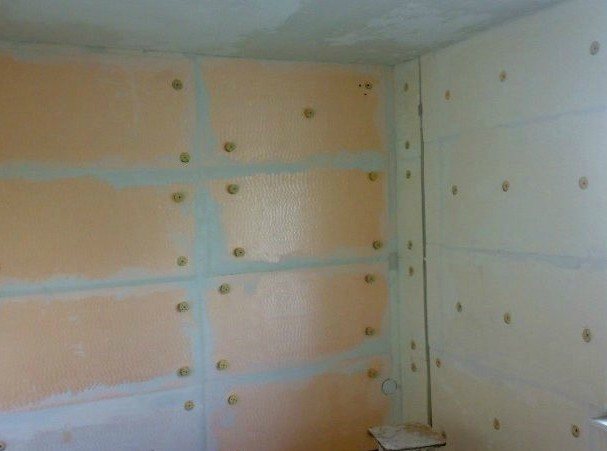

After the surface is completely finished with slabs, they begin to putty the joints. For this, a special type of sealant is used. Next, a special reinforcing mesh is mounted on the expanded polystyrene surface. Then, already on top of it, plaster is applied. At the final stage, the walls are painted.
Flammability class
The production of heat-resistant polystyrene foam is more expensive, the products are more expensive. The more perfect the modified technology, the lower the flammability of the resulting expanded polystyrene. All characteristics of non-combustible material must be indicated in the certificate.
Some suppliers of expanded polystyrene claim exceptional heat resistance, the foam polymer belongs to flammability classes G1 or G2. This is controversial information, often based on outdated flammability testing.
According to stricter government requirements, the first two flammability classes can only include products that do not form splashing drops. Expanded polystyrene, which is called non-combustible, does not possess such properties.
Suppliers often show video footage of a sample of non-combustible insulation suspended in the air being set on fire. In this position, drops of expanded polystyrene fall down, really, they do not splatter.
A completely different picture will be observed when igniting a sample lying on an incombustible substrate. Such shots are not often shown, because sparks flying in different directions from the focus lead to the fire in the end of the entire polystyrene sample. Non-flammable properties are not confirmed by video recording.
Perhaps some manufacturers modify the technology for producing expanded polystyrene, saturating it with fire retardants to the level of incombustibility of class G2. This is reflected in the product labeling, technical recommendations for use. It is worth remembering that modern methods do not allow to obtain completely non-combustible polystyrene foam.
Polyurethane
The closest neighbor in the rating of heaters is polyurethane foam, made of different monomers: isocyanate and polyhydric alcohol.
Unlike non-combustible polymerized styrene, polyurethane contains nitrogen. Theoretically, this fact allows us to speak of its greater thermal stability. When monomers are combined under the action of water, carbon dioxide is released. It has absolutely non-flammable properties.
The volume of gas in rigid types of polyurethane foam reaches 90%. The material is very lightweight, much more heat-resistant than foam.
Non-flammable properties are enhanced by adding flame retardants to the alcohol component. Currently, this component is required in the production of insulation. Information about the belonging of products made of foamed polyurethane to class G2, especially to G3, can be trusted.
Application
Thermal insulation of buildings with foamed polymers is a good economic solution to energy conservation issues. The installation of an outer polymer layer significantly reduces heat loss.
In our country, this is relevant in almost all regions. The materials have gained particular popularity in areas of harsh climates. When buying products, you need to carefully study the certificates, pay attention to the instructions regarding the location of the insulation.
Some materials are intended for installation on plinths and foundations only. It is necessary to find out the possible atmospheric, mechanical loads; recommended installation technique.
Analyzing information about all types of expanded polystyrene and other foamed polymers, you can make the right choice and ensure maximum safety.

